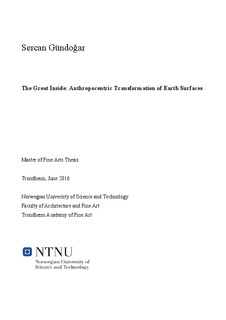| dc.description.abstract | The main focus of this work is the elusive boundaries of human civilization. Images investigate human marks on various landscapes and transformative characteristics of cultural and natural areas. Anthropocentric revolution of landscapes, as a contemporary discourse, motivates the subject matter of my current holistic approach to photographic practice; strongly highlighting a visual transformative story of nature which every species belongs. Dictated compositions, geometrical arrangements and over controlled landscapes are depicted to visualize the aspects of human mark. Manifestation of decreed compositions indicates imperious identity of humans and objectification process of other species. These landscape images also induce questioning notions of domesticated and wild and relationship between these concepts and human intersubjectivity. Influenced by Crutzen's term of 'Anthropocene' in different dimensions and Humboldt's approach towards hybrid identities of landscapes shape the research. Humboldt scientifically asserted the components of the heat an association of four different species; erica tetralix, vulgaris and two lichens1. Pointing out an association and hybrid identity of beings in light of Crutzen's and Humboldt's findings there is no singularity on the planet as such the photographs are visual narratives about complex associations.
It seems as though now, in the 21st century, all species carry the human mark. This is indicative of humanities increasingly affective relationship toward plant species . Composite identity of beings necessitate abandoning the idea of untouched nature. A result of the idea of the Great Inside comes up as accepted today's point of view. The engagement of beings in various stages is visual narrative of the images. Moreover, landscapes depicted in the photographs are minor examples of the human mark which are easy to notice on the outskirts of urban areas. Generally projects on human mark show vast and pessimistic environmental devastations. Conversely, I show minor and plenary influences of human on other species; photographs portray early stages of land colonization. | nb_NO |
